Cape bushbuck
| Cape bushbuck | |
|---|---|
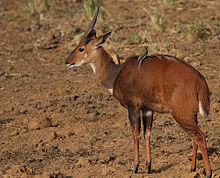
| |
| Male, Kenya | |
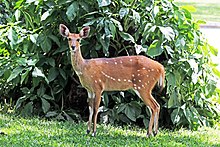
| |
| Female, Zimbabwe | |
| Scientific classification | |
| Domain: | Eukaryota |
| Kingdom: | Animalia |
| Phylum: | Chordata |
| Class: | Mammalia |
| Order: | Artiodactyla |
| Family: | Bovidae |
| Subfamily: | Bovinae |
| Genus: | Tragelaphus |
| Species: | T. sylvaticus
|
| Binomial name | |
| Tragelaphus sylvaticus (Sparrman, 1780)
| |
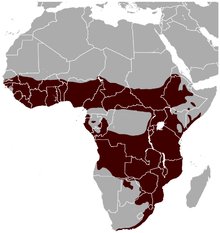
| |
| Combined range of Cape and harnessed bushbuck | |
The Cape bushbuck (Tragelaphus sylvaticus), also known as imbabala is a common, medium-sized
Taxonomy
| |||||||||||||||||||||||||||||||||||||||||||||||||||||||||||||||||||||
| Phylogenetic relationships of the mountain nyala from combined analysis of all molecular data (Willows-Munro et.al. 2005) |
The taxonomy of bushbuck, and of the
In 2011, Groves and Grubb advocated recognising eight species of bushbuck: T. scriptus (Pallas, 1766); T. phaleratus (Hamilton Smith, 1827); T. bor Heuglin, 1877; T. decula (Rüppell, 1835); T. meneliki Neumann, 1902; T. fasciatus Pocock, 1900; T. ornatus Pocock, 1900; and T. sylvaticus (Sparrman, 1780), grouped in a northern and southern 'group'.[4] The Ethiopian endemic species known as Menelik's bushbuck or decula was classified as a scriptus group species as opposed to Woodley. In the case of Tragelaphus, these 'species' would be based mostly on geography and pelage as opposed to genetics.[5] These proposals are controversial.[6]
In 2018, Hassanin et al. published a molecular phylogenetic study that provided support for the scriptus and sylvaticus species, with a divergence time of at least 2 million years, albeit with considerable genetic diversity within each of these groups.[7]
Description

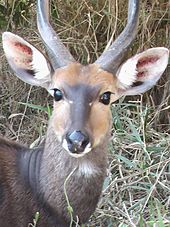
Cape bushbucks stand around 90 cm (35 in) at the shoulder and weigh from 60 to 80 kg (130 to 180 lb) in males and 25 to 60 kg (55 to 132 lb)in females.[8] They have a light brown coat, with up to seven white stripes and white splotches on the sides. The white patches are usually geometrically shaped and on the most mobile parts of their bodies, such as the ears, chin, tail, legs, and necks. The muzzles are also white. Horns, found only on the males, can reach over half a metre and have a single twist. At 10 months old, young males sprout horns that are particularly twisted and at maturity form the first loop of a spiral.[9]
The Cape bushbuck has on average less striping and more uniform colouration than populations in West Africa.[3] Cape bushbuck occur from the Cape in South Africa to Angola and Zambia and up the eastern part of Africa to Ethiopia and Somalia, according to one interpretation.[10] Other interpretations restrict the taxon to Southern Africa sensu stricto or consider them sensu lato to occur in the above range except eastern Sudan, Ethiopia, and Somalia.[5] The first Latin name that can be attributed to the Cape bushbuck was Antilope sylvatica after Sparrman (1780), described from the Cape Colony.[citation needed]
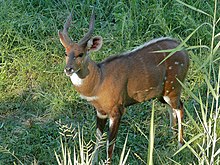

Ecology
Bushbuck
Bushbuck are solitary animals, but are not aggressively antisocial, and individuals sometimes forage in close proximity.[13] Bushbuck live within a "home" area, which is usually around 50,000 m2 on the savannah and much larger in the forest, that they will not normally leave. These areas usually overlap other bushbuck home areas.
Some game farmers in southern Africa discovered that the bushbuck may compete with the closely related, larger nyala when they tried to introduce the two species to the same area. However, the two species are often found in close proximity in natural communities (e.g., in Gorongosa National Park, Mozambique).[14]
References
- . Retrieved 18 January 2024.
- ^ Wronski T, Moodley Y. (2009). Bushbuck, harnessed antelope or both? Archived 2011-07-08 at the Wayback Machine Gnusletter, 28(1):18-19.
- ^ . Retrieved 7 April 2021.
- ISBN 978-1-4214-0093-8.
- ^ a b Groves, C.; Grubb, P. (2011). Ungulate Taxonomy. The Johns Hopkins University Press.
- PMID 23362112.
- S2CID 52038847.
- ^ Haltenorth, T., & Diller, H. (1977). Säugetiere Afrikas und Madagaskars. (No Title).
- ^ "Bushbuck". African Wildlife Foundation. Retrieved June 28, 2008.
- ^ Moodley Y, Bruford MW. (2007) Molecular biogeography: Towards an integrated framework for conserving pan-African biodiversity. PLoS ONE. 2:e454.
- S2CID 73492605.
- PMID 35994662.
- ISBN 978-0-520-08085-0.
- S2CID 250587376.
External links
- . Encyclopædia Britannica (11th ed.). 1911.
- New International Encyclopedia(1st ed.). New York: Dodd, Mead.

